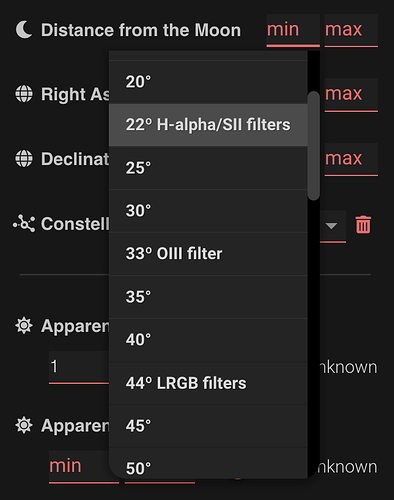First of all, a HUGE thanks for providing this site. It’s absolutely the best for planning my imaging sessions and I tell everyone about it. I’d like to submit an enhancement request. It would be AWESOME if you could show me the “Tonight’s Moonless Imaging Window”. This would be the Start Time and Stop Time, and Total Imaging Time between the end of Astronomical Twilight on the night that I start (like January 5th) and the start of Astronomical Twilight the next morning (January 6th) when the moon is below the horizon. One step further would be to show these times assuming that I only do my imaging when my targets are XX degrees above the horizon. This would let me know the entire usable window of imaging time for the day that’s selected. Thanks! Mark
Hi Mark, welcome to the forum and thank you for your suggestion!
I like the idea of showing the total available time for imaging, and in fact I’m planning to add something like that in the search page. Right now you can filter by the minimum amount of time above the minimum altitude, but there is no easy way of knowing the total number of hours above that altitude.
Regarding the moonless imaging window considering the session start/end time and the astronomical night, the problem is the available “moonless” window actually varies from target to target. Just to mention an example, you might have a “moonless imaging window” of 2 to 3 hours in the days around a Full Moon, but if the target is close to the Moon it might be pointless to try and image it at all.
To avoid the Moon brightness, I strongly suggest using the “Distance to the Moon” filter when searching for DSOs. This lets you see targets with average distances to the Moon not less than what you set. You also have new dynamic options when using filters (h-alpha, s2, o3 and lrgb) that calculate the minimum suggested distance depending on the filter you are using and the current moon illumination. For imaging without filters or for visual astronomy, the LRGB suggestion works well too.
This approach will let you find much more targets than a single moonless window for the entire night.
I hope this helps!
